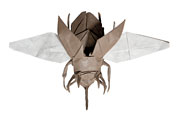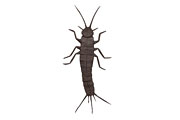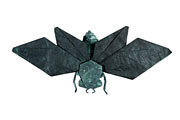|

Flying Eupatorus, opus 368 |

Silverfish, opus 449 |

Flying Cicada, opus 329 |
| (Click on image for larger version) |
Much more than paper hats
Artist Robert Lang has folded intricate paper sculptures from flat sheets that, in some cases, started out over nine feet long. He uses the same method many of us used to make cranes and party hats in elementary schoola series of precise folds. But Langs designs are far more complex. Using advanced mathematics, Lang can fold a snake with 1000 scales from a single sheet of uncut paper. And thats just the beginning.
Lang is a retired physicist and engineer with a PhD from Caltech. Now a full-time origamist, he creates seemingly impossible designs by breaking complicated geometry problems into a series of steps, or algorithms, that can be solved by a computer. Langs algorithms have pioneered a new field of mathematics called computational origami.
Langs computational origami inspired a young MIT computer science professor, Erik Demaine, to solve a famous geometry problem called fold-and-cut. The question is simple: How many two-dimensional shapes can you get by folding a paper any number of times, as if to make a paper-snowflake, and then making only one straight cut? The fold-and-cut problem had puzzled mathematicians for years. But in 1998, after two years of crunching origami algorithms and mathematical proofs, Demaine came up with a surprising solution: you can theoretically create any designfrom a snowflake, to a detailed silhouette of the Eiffel Towerafter making just one cut in the paper. Of course, some shapes are just not feasible in real life, explains Demaine, but in theory, literally any shape could be made after just one straight cut.
Origami has been used to solve engineering problems too. Langs algorithms have improved airbags and expandable space telescopes by increasing the area that can fold out from a small volume, like a multifaceted pop-up book. Taking these principles even further, bioengineers are now using computational origami to understand how the body works and improve medical devices. Langs method could help researchers understand how proteins fold in our bodies, for example, so we can treat protein-folding disorders such as mad cow disease. Origami may also help unclog our arteries by improving the traditional stents used in coronary surgery. A physician can route a tiny origami stent through a blood vessel and then expand it, lodging the device in the larger artery that needs support.
Of course, not all of Langs designs save lives; some just look cool. Each piece shown here, from the scorpion with pincers to the winged cicada, was folded from a single sheet of paper. They are vivid, almost eerie, reminders that math can be beautiful.
|
